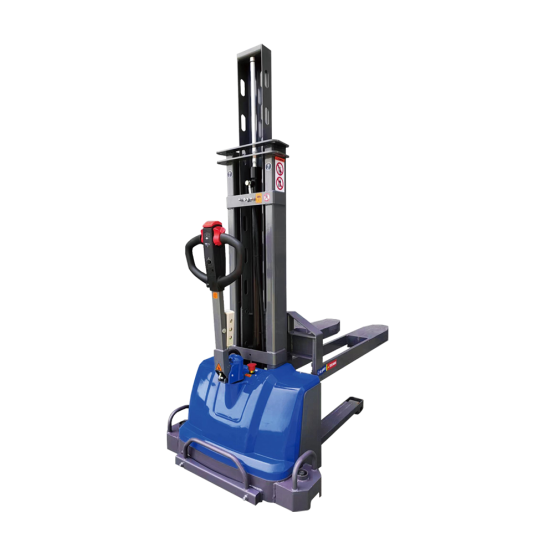In the fast-paced world of logistics and warehousing, efficiency is key. As businesses strive to meet increasing demands, the need for innovative material handling solutions has never been greater. Among these solutions, self-lifting stackers have emerged as a revolutionary tool, transforming the way goods are stored, moved, and managed within warehouses. This guide explores the benefits, functionality, and impact of self-lifting stackers, offering insights into why they are becoming an indispensable asset in modern warehouse operations.
What Are Self-Lifting Stackers?
Self-lifting stackers, also known as **self-propelled stackers**, are advanced material handling devices designed to lift, transport, and stack goods with minimal manual effort. These machines are compact, agile, and equipped with a built-in lifting mechanism, making them ideal for navigating narrow aisles and confined spaces. Unlike traditional forklifts, self-lifting stackers are operated by a single user and are specifically designed to handle palletized loads with precision and ease.
Key Features of Self-Lifting Stackers
1. Compact Design: Their small footprint allows them to operate efficiently in tight spaces, maximizing warehouse storage capacity.
2. Self-Propelled Operation: Powered by electric motors, these stackers reduce the physical strain on operators, enhancing productivity and safety.
3. Lifting Mechanism: Equipped with hydraulic or electric lifting systems, they can effortlessly raise and lower loads to desired heights.
4. Maneuverability: With advanced steering systems, self-lifting stackers can navigate sharp turns and narrow aisles with ease.
5. Versatility: They can handle a wide range of loads, including pallets, crates, and containers, making them suitable for diverse warehouse applications.
Benefits of Self-Lifting Stackers
1. Enhanced Efficiency
Self-lifting stackers streamline material handling processes, reducing the time required to move and stack goods. Their ability to operate in confined spaces ensures optimal use of warehouse floor space.
2. Improved Safety
By eliminating the need for manual lifting, these stackers significantly reduce the risk of workplace injuries, such as strains and sprains. Their ergonomic design also ensures operator comfort during prolonged use.
3. Cost-Effective
Compared to traditional forklifts, self-lifting stackers are more affordable to purchase and maintain. Their energy-efficient operation also contributes to lower operational costs.
4. Ease of Use
With intuitive controls and minimal training requirements, these stackers can be operated by almost anyone, reducing the need for specialized personnel.
5. Environmental Friendliness
Most self-lifting stackers are electrically powered, producing zero emissions and contributing to a greener warehouse environment.
Applications of Self-Lifting Stackers
Self-lifting stackers are versatile tools that can be used in a variety of warehouse settings, including:
Retail Warehouses: For stacking and organizing palletized goods.
Manufacturing Facilities: For transporting raw materials and finished products.
Cold Storage Units: For handling goods in temperature-controlled environments.
E-Commerce Fulfillment Centers: For managing high volumes of small to medium-sized loads.
How Self-Lifting Stackers Revolutionize Warehouse Operations
1.Space Optimization: Their compact design allows warehouses to utilize vertical storage space more effectively, increasing overall storage capacity.
2. Faster Order Fulfillment: By speeding up the movement of goods, these stackers help reduce lead times and improve customer satisfaction.
3. Reduced Labor Costs: Automating material handling tasks reduces the need for manual labor, leading to significant cost savings.
4. Scalability: As businesses grow, self-lifting stackers can easily adapt to increased workloads without requiring major infrastructure changes.
Choosing the Right Self-Lifting Stacker
When selecting a self-lifting stacker for your warehouse, consider the following factors:
Load Capacity: Ensure the stacker can handle the maximum weight of your typical loads.
Lift Height: Choose a model that can reach the required stacking heights in your facility.
Battery Life: Opt for stackers with long-lasting batteries to minimize downtime.
Maneuverability: Assess the turning radius and ease of navigation in your warehouse layout.
Safety Features: Look for features such as automatic braking, overload protection, and ergonomic controls
Conclusion
Self-lifting stackers are revolutionizing warehouse operations by combining efficiency, safety, and versatility into a single, cost-effective solution. As warehouses continue to evolve, these innovative machines are set to play an increasingly important role in optimizing material handling processes. Whether you're looking to enhance productivity, reduce costs, or improve workplace safety, self-lifting stackers offer a powerful tool to help you achieve your goals.
By investing in this cutting-edge technology, businesses can stay ahead of the competition and meet the growing demands of the modern supply chain. Embrace the future of warehouse efficiency with self-lifting stackers and unlock the full potential of your operations.

| 


 Chinese
Chinese USA
USA English
English Russia
Russia